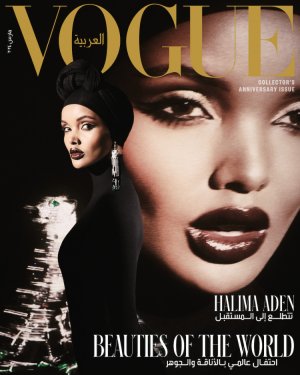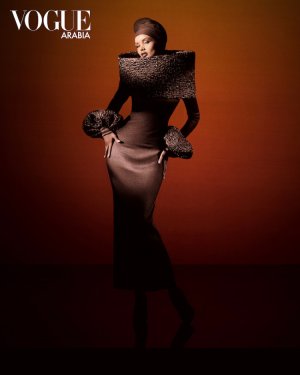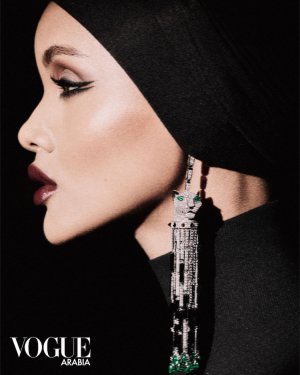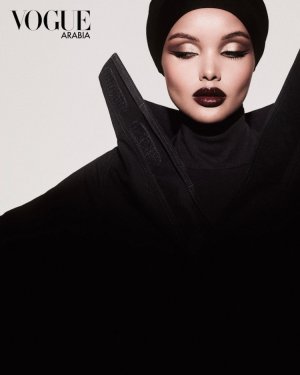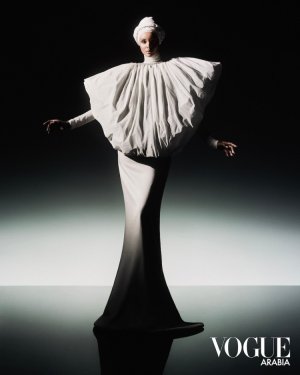simplylovely
Well-Known Member
- Joined
- Apr 30, 2006
- Messages
- 29,399
- Reaction score
- 1,140
^ Love these shots!
Announcing... The 3rd annual theFashionSpot Awards for 2025. Vote NOW via the links below:
Designer of the YearThank you for participating!
VOTING WILL CLOSE 29/12/2025 EOD!
Harper's Bazaar Arabia Feb 2020: The Face of Hope
Here’s the full cover story from Harper’s Bazaar Arabia:
“Where’s Halima?!” our photographer Yulia asks, looking left and right across the savanna, a slight twinge of concern creeping in to her inflection. Our crew is slowly turning pink under the beating African sun, battling mosquitoes but thankfully nothing larger, exhausted but emotional in all the best possible ways.
Halima, as it happens, is in a far-flung corner, taking selfies with some locals, chatting, laughing, swapping stories and singing what is to become the refrain of the entire trip; Jambo Bwana – the joyful Swahili pop number that makes Hakuna Matata seem stern in comparison.
And honestly – she is the song; the most happy-go-lucky, contagiously upbeat person you could hope to meet, Halima is the definition of Little Miss Sunshine, or perhaps the Disney princess with the dazzling smile that everyone wanted to grow up to be. So it’s little wonder that when we’re looking for her, eager to get the next shot done, she’s busy doing what she’s best at. Spreading light.
Sitting firmly in glass-half-full territory – possibly even the queen of it – Halima’s positivity seems so natural and easy that you’d be forgiven for thinking it was simply innate. The real story, however, is far more complex; filled with darkness but, crucially, darkness that became armour, before giving way to the brightest dawn possible.
Halima’s mother travelled for 12 days on foot to escape the Somali Civil War and enter Kenya, eventually finding a home in Kakuma refugee camp where Halima was born. A northwestern settlement near the border with Somalia that today houses around 191,500 displaced people fleeing their homes, Halima lived there until the age of seven when her family relocated to the States with the help of UNHCR.
“I used to live in one of those,” she points out of the window of our 4×4 as we speed between locations in Nairobi. It’s a shanty town built on nothing but dirt; a cluster of shacks at the side of the road, cobbled together using rough, corrugated metal sheets. Windowless, precarious and, quite frankly, heartbreaking, it is no place for anyone, let alone a child.
“I was forced to confront some of the world’s biggest issues before I was five,” the 22-year-old explains when we press her about how she acquired such strikingly beyond-her-years wisdom. “Malnutrition, malaria, often my mum wasn’t there as she was meeting the UNHCR people trying to get us out of the camp…” she trails. “You don’t have a say in where you’re born, or what environment, or what kind of family you’re in, but I saw it all as a kind of gift from the universe – one that came with the need to problem-solve. You need that philosophy and you need to have a certain view to survive. That’s definitely me.”
It certainly puts a bad day at the office into pretty sharp perspective. Halima’s story is so improbable – refugee child turned US immigrant turned game-changing cultural icon (she was the first hijabi model to ever walk the runways of Milan and Paris) – that you instantly realise why she’s so permanently cheerful. “My family won the billion-dollar lottery being able to leave that camp,” she half-laughs, still audibly incredulous. “It’s something crazy like only 1 per cent of refugees get to relocate to somewhere like America. We were such a rare case.”
Even if others had gone through the same hardships and emerged triumphant from the other side, it’s still hard to imagine anyone else recounting the journey with such optimism. “It’s a choice,” Halima insists. “Every day, you have to choose to look at things positively. I know that if I do, it impacts everything… my actions, my views, my opinions, and it gives me a soft cushion for when things do go wrong.”
Against a tumultuous and uncertain global backdrop – perhaps rockier now than ever – Halima’s is a life-affirming mission statement we could all do with remembering. “No matter how grim things may seem, there are always so many people in this world who are trying to fight the good fight. And you have to remind yourself that you are not alone – that there are so many people like you that want the same.” She smiles. “That makes me look at the future in a hopeful light. I really do believe people are born good.”
Our shoot in Kenya is not only Halima’s first-ever ready-to-wear editorial photographed in her home country (“I have three places I can call home,” she tells us – Somalia, Kenya and the US. “How lucky am I?!”), but also an emotional return after her trip back to Kakuma a year and a half ago. As she stands overlooking the majestic peaks of the Ngong Hills, tears fill her eyes as she reminds us how fortunate we are to experience being right here, right now.
“Not many people in their lifetime get to experience this,” she says, proud and full of love. “Kenya taught me so many valuable lessons that I will carry with me forever,” she continues. “And you know, a refugee camp is definitely not the ideal place to raise kids, but for me at least, it was still a good childhood because there was a community. Even today, it’s still 66 per cent women and children so it’s a nurturing environment because you’ve got a lot of mamas! Even when my mum was away, I had 10 mums looking after me.”
Halima’s trip back to Kakuma saw her give the first-ever TED talk in a refugee camp, using it to announce her appointment as a UNICEF ambassador. “That was the highlight of my career,” she says without skipping a beat. Not walking for Kanye’s Yeezy, not fronting campaigns for Max Mara, not working with Rihanna on Fenty Beauty… no, Halima’s self-proclaimed apex was typically altruistic – going back home to inspire, encourage and give back. “I studied International Relations,” she laughs, “I always wanted to work at the UN when I was older. I remember seeing the UNICEF workers – ‘the people in the blue shirts,’ I used to call them – and wanting to be just like them when I grew up. It’s kind of crazy how if you put stuff out into the universe, things will manifest themselves perfectly.”
Halima is also proof that in today’s world, models – as much as magazines – are looked to as engineers of change. Neutrality is no longer an option, with the leading lights of the industry spearheading a bright, conscious new dawn that we can all be proud to be a part of. And while fashion and activism have always been bedfellows, their interconnectivity is now more important than ever. Put simply – fashion needs feeling. And Halima is the perfect ambassador for this kind of meaningful call-to-arms. Why? Because she’s lived to tell the tales.
“I’m walking proof that the UNICEF work is going towards something real.” Not only towards something real, we offer, but towards a person who has taken the opportunities and amplified them in one of the world’s biggest and most visible arenas – fashion. In fact, Halima is arguably more of a totem of change when it comes to the modestwear movement than her work with UNICEF, known for pioneering a much-needed sea change of diversity in beauty and fashion.
“When I entered Miss Minnesota as the first girl to wear a hijab in a Miss USA pageant, I had absolutely no idea the cultural impact it would have,” Halima tells us. “I had a feeling it would give me the platform that I needed to go back to my old high school and, just at a local level, tell girls, ‘hey, you can play sports, you can join the school teams – look at me, I competed in Miss Minnesota and got to be myself!’” she explains. “But it ended up just creating the perfect noise. You have to remember, we were living in a time when there was nothing – barely even a burkini – so I didn’t even learn how to swim until around 2016,” she shakes her head. “It just showed there was a community of women and a market that we’d pretty much ignored. I think the fact that I can even have a successful career in fashion like I do today tells you how much change needed to happen over the years for me to have a place in this industry,” she says. “But is there more we can do? Always. Sometimes, at the beginning I felt that I was getting too much credit for something that had really been around for ages. Modesty is so normal, it’s not a new concept. But then I got so many messages from Muslims around the world and it made me think, ‘Ok, that was needed.’ I’m just hoping it doesn’t end with me. The conversation still needs to go on.”
Unwittingly, Halima’s boundary-breaking turn on stage at Miss Minnesota launched a global movement – self-acceptance being a huge cornerstone of it. Her now-famous motto, “Don’t change yourself, change the game,” has resonated far beyond just young hijabis longing to see someone that looked like them on catwalks and in magazines. Indeed, it can be appropriated by those in the margins now finally seeing themselves represented in the mainstream.
“Everyone should have that one motto,” Halima says. “Something you can say to pump you up – kind of like putting on a Beyoncé song!” she laughs. “For me, growing up I needed something to say to myself to keep me unafraid, almost like a promise. I don’t need to conform to fit in and I don’t need to sway my values. I am me and I will always be true to myself.” She continues, “It’s so lovely to see other girls saying the same motto. Now it’s something not just for me, I share it with my community, too.”
It’s astounding to think that we had to wait until 2016 to see a hijabi model take to the runway of two major fashion capitals, but of all the poster girls to do it, we can’t think of a better one than Halima.
“The best thing is I could never have told you how my career was going to pan out,” she giggles. “I always kept an open mind going into this industry and I don’t want to lose that. One of the things I love about fashion events is that you never know what’s going to happen, like when I met [filmmaker] Sonia Nassery Cole. She told me all about the film she was working on, which then led to conversations about me executive producing.”
The film in question is I Am You – the true story of Afghan refugees and their will to survive, out this month and listed as an official submission at this year’s Golden Globes. “I believe in the resilience of the human spirit,” Halima says, “I’ve always talked about my journey, but to have this tool to visualise the story… that’s powerful. But solutions are more important than pity.”
Halima’s latest initiative, her partnership with #TOGETHERBAND as their brand ambassador for the UN’s Global Goal 8: Decent work and economic growth, seeking to eradicate the number of workers living in extreme poverty by 2030, is the perfect example of her turning talk into action. “You’re bombarded with negative, heartbreaking stories about refugees… and it is the reality. But at the same time, I want to showcase my story, which is someone who was able to go from a refugee child to using her modelling career to support organisations and highlight the work they’re doing. It isn’t always bad, and sometimes you can find stories from people who have had incredible journeys of hope. When you invest in the kids and communities that need it the most, you’re able to see more stories like mine.” More stories like Halima’s. What a beautiful world that would be.
